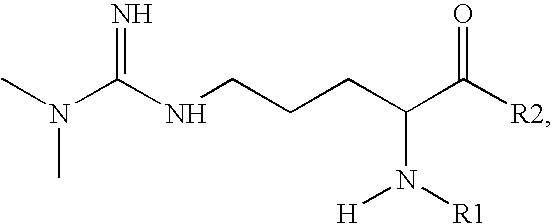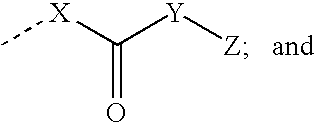Arginine Analogs, and Methods for Their Synthesis and Use
a technology of arginine analogs and analogs, applied in the field of new drugs, can solve the problems of elevated adma, a risk factor for hypertension, cardiovascular disease, renal failure, etc., and achieve the effect of stimulating an immune respons
- Summary
- Abstract
- Description
- Claims
- Application Information
AI Technical Summary
Benefits of technology
Problems solved by technology
Method used
Image
Examples
example 1
Synthesis of Amino-substituted Thioester Derivative of ADMA
[0088]
[0089]ADMA (47.99 g, Sigma-Aldrich) was added to a 10 mL round-bottom flask. Acetonitrile (1 mL) was added, followed by solid N-succinimidyl-S-acetylthiopropionate (SATP, 73 mg, Molecular Bioscience, Inc.), and the mixture stirred until dissolved. Dry diisopropylethylamine (86 μL) was added, and the flask purged with argon and sealed. The reaction mixture was sonicated, and stirred overnight at room temperature.
[0090]The solid product (1) was collected by filtration, rinsed with 2×1 mL acetonitrilen and 2×1 mL ethyl ether.
example 2
Synthesis of N-bromoacetyl-L-homocysteine Thiolactone (2)
[0091]Pyridine (1.7 mL) was added to a stirring solution of bromoacetic acid and L-homocysteine thiolactone hydrochloride (1.54 g) in dry dimethylformamide (50 mL). The solution was treated with 1-Ethyl-3-(3-dimethylaminopropyl)-carbodiimide (2.11 g), and stirred overnight at room temperature under an argon atomosphere. The dimethylformamide was evaporated, and the residue treated with 20 mL water. The product (2) was collected by filtration, washed with water a second time, and dried under vacuum.
Example 3
Synthesis of Amino-substituted Thiolactone Derivative of ADMA
[0092]
[0093]ADMA (50 mg) and (2) (64 mg) were stirred in dimethylformamide (2.5 mL), and diisopropylethylamine (130 μL was added. The reaction mixture was stirred at 80° C. under argon for 5 days. The dimethylformamide was evaporated under vacuum, and the residue dissolved in water (3 mL), which was then extracted with methylene chloride (3×5 mL), which was centrif...
example 3
Synthesis of Carboxyl-substituted Thiolactone Derivative of ADMA
[0094]
[0095]A solution of t-boc-NG,NG-dimethylarginine-L-homocysteine thiolactone (22 mg) in methylene chloride (500 μL) was treated with trifluoroacetic acid (500 μL), and allowed to stand at room temperature for 2 hours. The solvent was evaporated, and the clear residue dried under vacuum. The residue was then treated with ether (1 mL), sonicated, and evaporated to remove residual trifluoroacetic acid. The residue was again treated with ether (1 mL), and precipitated as a solid. The solid was triturated with ether (1 mL) and dried under vacuum to afford (4).
PUM
| Property | Measurement | Unit |
|---|---|---|
| Structure | aaaaa | aaaaa |
| Fluorescence | aaaaa | aaaaa |
Abstract
Description
Claims
Application Information
 Login to View More
Login to View More - R&D
- Intellectual Property
- Life Sciences
- Materials
- Tech Scout
- Unparalleled Data Quality
- Higher Quality Content
- 60% Fewer Hallucinations
Browse by: Latest US Patents, China's latest patents, Technical Efficacy Thesaurus, Application Domain, Technology Topic, Popular Technical Reports.
© 2025 PatSnap. All rights reserved.Legal|Privacy policy|Modern Slavery Act Transparency Statement|Sitemap|About US| Contact US: help@patsnap.com



